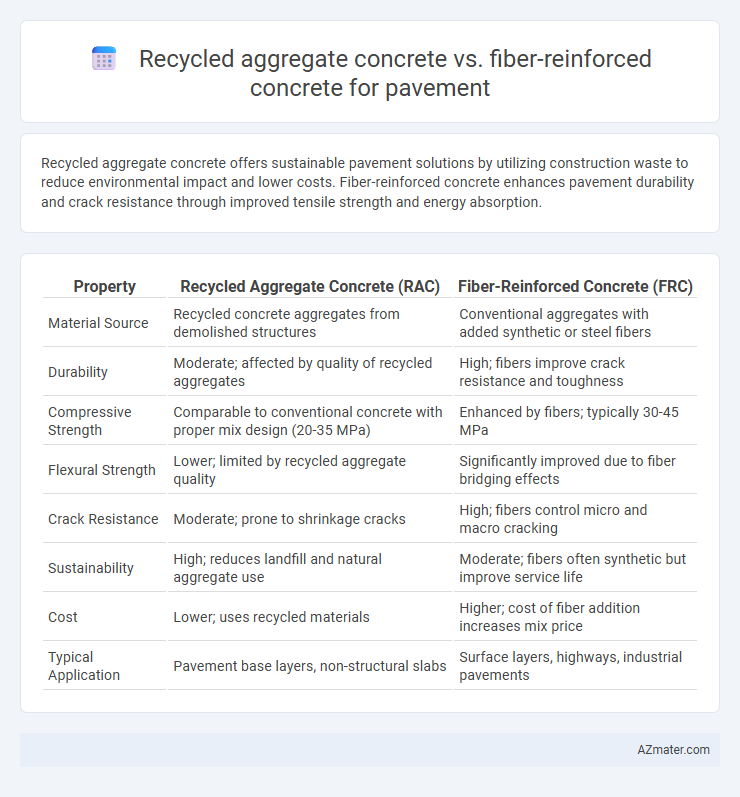Recycled aggregate concrete offers sustainable pavement solutions by utilizing construction waste to reduce environmental impact and lower costs. Fiber-reinforced concrete enhances pavement durability and crack resistance through improved tensile strength and energy absorption.
Table of Comparison
| Property | Recycled Aggregate Concrete (RAC) | Fiber-Reinforced Concrete (FRC) |
|---|---|---|
| Material Source | Recycled concrete aggregates from demolished structures | Conventional aggregates with added synthetic or steel fibers |
| Durability | Moderate; affected by quality of recycled aggregates | High; fibers improve crack resistance and toughness |
| Compressive Strength | Comparable to conventional concrete with proper mix design (20-35 MPa) | Enhanced by fibers; typically 30-45 MPa |
| Flexural Strength | Lower; limited by recycled aggregate quality | Significantly improved due to fiber bridging effects |
| Crack Resistance | Moderate; prone to shrinkage cracks | High; fibers control micro and macro cracking |
| Sustainability | High; reduces landfill and natural aggregate use | Moderate; fibers often synthetic but improve service life |
| Cost | Lower; uses recycled materials | Higher; cost of fiber addition increases mix price |
| Typical Application | Pavement base layers, non-structural slabs | Surface layers, highways, industrial pavements |
Introduction to Sustainable Pavement Materials
Recycled aggregate concrete (RAC) incorporates reclaimed construction waste, reducing landfill usage and demand for virgin aggregates, making it a key sustainable pavement material. Fiber-reinforced concrete (FRC) enhances pavement durability and crack resistance by integrating synthetic or natural fibers, extending the lifespan of road surfaces. Both materials address environmental challenges by promoting resource efficiency and improving structural performance in modern pavement systems.
Overview of Recycled Aggregate Concrete
Recycled aggregate concrete (RAC) utilizes reclaimed concrete materials, reducing environmental impact and conserving natural resources by replacing virgin aggregates with recycled ones. Its strength and durability depend on factors such as quality of recycled aggregates, mix design, and proper treatment of contaminants, making it a viable option for sustainable pavement construction. RAC offers cost savings and improved waste management while maintaining adequate performance in pavement applications compared to traditional concrete.
Key Properties of Fiber-Reinforced Concrete
Fiber-reinforced concrete (FRC) enhances pavement durability through improved tensile strength, crack resistance, and impact absorption compared to recycled aggregate concrete (RAC). The inclusion of synthetic or steel fibers in FRC significantly increases flexural strength and controls shrinkage cracks, leading to extended service life in pavement applications. Fiber content and distribution critically influence the mechanical properties, making FRC a preferred choice for pavements requiring high load-bearing capacity and resistance to fatigue.
Environmental Impact Comparison
Recycled aggregate concrete (RAC) significantly reduces landfill waste and lowers natural resource depletion by reusing crushed concrete from demolition, thereby decreasing the carbon footprint compared to traditional concrete. Fiber-reinforced concrete (FRC) enhances pavement durability and reduces maintenance frequency, indirectly minimizing environmental impact through extended service life and reduced material consumption. Both materials contribute to sustainable pavement solutions, but RAC offers more direct environmental benefits in resource conservation and waste reduction.
Mechanical Performance and Durability
Recycled aggregate concrete (RAC) demonstrates moderate mechanical performance with compressive strength typically ranging between 20-40 MPa, benefiting pavement sustainability by utilizing construction waste, but it often exhibits higher porosity and potential durability challenges such as freeze-thaw damage. Fiber-reinforced concrete (FRC), incorporating synthetic or steel fibers, enhances tensile strength, flexural strength, and crack resistance, delivering superior load-bearing capacity and improved durability against fatigue and environmental degradation in pavement applications. Combining recycled aggregates with fiber reinforcement can synergistically improve mechanical performance and durability, addressing common weaknesses in RAC by reducing permeability and controlling crack propagation under repeated traffic loading.
Cost Analysis and Economic Feasibility
Recycled aggregate concrete reduces material costs by utilizing demolition waste, offering a sustainable alternative that lowers expenses associated with virgin aggregates and landfill fees. Fiber-reinforced concrete, while more expensive initially due to fiber additives, enhances pavement durability and reduces maintenance frequency, leading to long-term economic benefits. Cost analysis reveals that recycled aggregate concrete excels in upfront savings, whereas fiber-reinforced concrete provides improved life-cycle cost efficiency, making combined use a strategically feasible option for pavement projects focused on sustainability and cost-effectiveness.
Construction Techniques and Challenges
Recycled aggregate concrete (RAC) for pavement requires specialized sorting and cleaning techniques to ensure aggregate quality, posing challenges in achieving consistent mechanical properties and durability. Fiber-reinforced concrete (FRC) involves integrating synthetic or steel fibers into the mix, enhancing tensile strength and crack resistance but demanding precise fiber distribution to avoid clumping and uneven performance. Both materials face construction challenges, including mixing complexity, workability control, and adaptation of standard equipment to maintain pavement integrity and longevity.
Case Studies in Pavement Applications
Case studies in pavement applications demonstrate that recycled aggregate concrete (RAC) offers sustainable benefits by utilizing construction waste while maintaining adequate compressive strength and durability for low to medium traffic roads. Fiber-reinforced concrete (FRC) enhances pavement performance through improved tensile strength, crack resistance, and fatigue durability, making it suitable for heavy traffic and industrial pavements. Comparative analyses reveal that combining RAC with fiber reinforcement can optimize both environmental sustainability and mechanical performance in pavement structures.
Maintenance and Long-Term Performance
Recycled aggregate concrete (RAC) demonstrates sustainable benefits with slightly higher maintenance needs due to potential durability challenges from residual impurities affecting long-term performance under cyclic loading. Fiber-reinforced concrete (FRC) offers enhanced crack resistance and improved fatigue life, significantly reducing maintenance frequency and extending pavement lifespan by mitigating micro-cracking and rutting. Combining fibers with recycled aggregates can optimize durability and sustainability, but fiber content and aggregate quality must be carefully controlled for optimal long-term pavement performance.
Recommendations for Material Selection
Recycled aggregate concrete offers sustainable benefits by reducing natural resource consumption and providing adequate strength for base layers in pavement construction. Fiber-reinforced concrete enhances tensile strength, crack resistance, and durability, making it suitable for wearing surfaces subjected to heavy traffic loads. For optimal pavement performance, select recycled aggregate concrete for sub-base applications and fiber-reinforced concrete where high flexural strength and impact resistance are critical.

Infographic: Recycled aggregate concrete vs Fiber-reinforced concrete for Pavement
 azmater.com
azmater.com